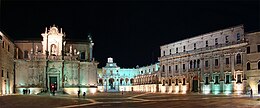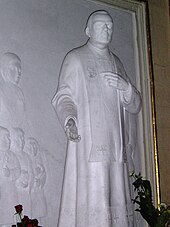Lecce
[7] "Lecce stone"—a particular kind of limestone[8]—is one of the city's main exports, because it is very soft and workable, and thus suitable for sculptures.
[10] Under the emperor Hadrian (2nd century AD) the city was moved 3 kilometres (2 miles) to the northeast, taking the name of Licea or Litium.
[11] After the fall of the Western Roman Empire, Lecce was sacked by the Ostrogoth king Totila in the Gothic Wars.
To avert invasion by the Ottomans, a new line of walls and a castle were built by Charles V (who was also Holy Roman Emperor), in the first part of the 16th century.
In 1943, fighter aircraft based in Lecce helped support isolated Italian garrisons in the Aegean Sea during World War 2.




